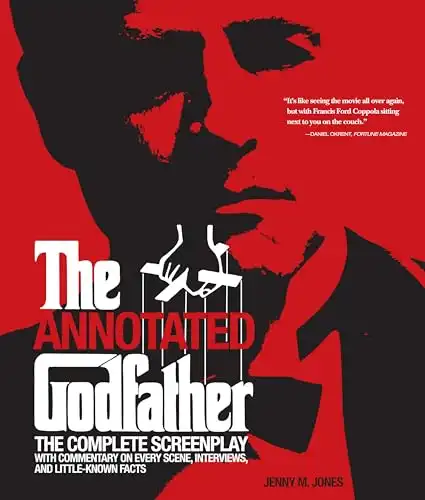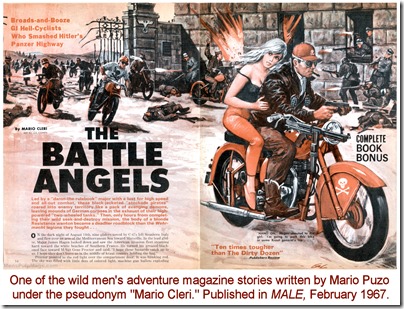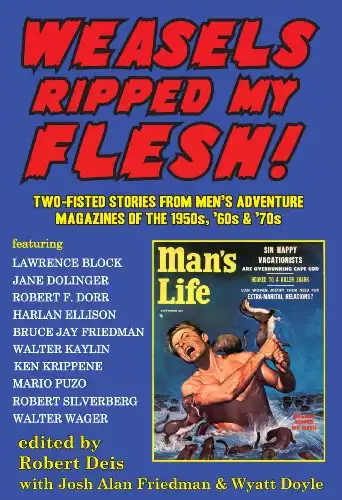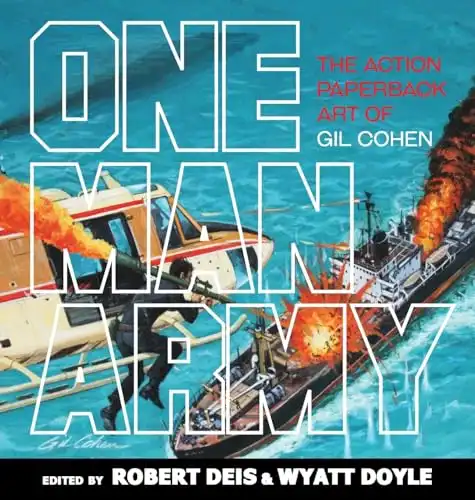I’m a big fan of the Mario Puzo’s 1969 novel The Godfather and the movie that was made from it in 1972.
I am also a big fan of vintage men’s adventure magazines. In fact, I write a blog about them (MensPulpMags.com).
I also co-edit anthologies of classic men’s adventure magazine stories for the Men’s Adventure Library book series published by New Texture Books.
If you’re not a fan of those venerable periodicals from the 1950s, 1960s and 1970s, you may not know that Mario Puzo made his living writing wild action and adventure stories for them before The Godfather made him famous.
Puzo wrote some of his men’s adventure yarns under his own name. But the majority were written under the pseudonym “Mario Cleri.”
And he wrote a lot of them. I’d guesstimate around 200. (An example of a men’s adventure yarn Puzo wrote under the pen name Mario Cleri, featuring artwork by Gil Cohen, is shown below.)
Most of those stories appeared in men’s adventure magazines published by subsidiaries of Magazine Management, the publishing company owned by Martin Goodman.
Magazine Management put out some of the best men’s adventure mags, such as Action for Men, For Men Only, Male, Man’s World, Men and Stag. (It also launched Marvel Comics.)
Puzo was hired as a Magazine Management writer around 1959 by Bruce Jay Friedman, another talented writer who worked for the company before he became a world famous novelist (and playwright and scriptwriter). At the time, Friedman was the editor of several of the company’s men’s adventure magazines and its Playboy competitor, Swank.
 Puzo had written one novel before joining the Magazine Management staff. He wrote several others in his spare time while working for the company in the 1960s.
Puzo had written one novel before joining the Magazine Management staff. He wrote several others in his spare time while working for the company in the 1960s.
But he didn’t become successful as a novelist until 1969, when his fifth novel, The Godfather, was published on March 10 of that year by Putnam’s.
The iconic cover of the novel with the hand holding the marionette control bar (later used for the movie posters) was designed by S. Neil Fujita.
Not long after The Godfather was published, Puzo stopped writing for men’s adventure magazines. But he maintained warm relations with Magazine Management.
In August 1969 an abridged version of The Godfather was featured in the August 1969 issue of Male, along with an outstanding Godfather-themed cover painting by Mort Kunstler (shown at right) and equally cool interior illustrations by Earl Norem (shown below).
Puzo didn’t reach the height of his fame until a few years later, after the movie became a critical smash and box office blockbuster.
Although the movie is a fairly faithful adaptation of the novel by Hollywood standards, largely because Puzo co-wrote the script with director Francis Ford Coppola, there are some differences. One is related to the movie’s best known line.
Early in the novel, the Italian singer and actor Johnny Fontane tells Mafia “Godfather” Don Vito Corleone that a Hollywood movie executive had refused to give him a role he wanted in an upcoming film.
Don Corleone tells Johnny he’ll convince the studio executive to change his mind. When Johnny seems skeptical, Corleone gives a simple explanation of why he’s confident:
“He’s a businessman,” the Don said blandly. “I’ll make him an offer he can’t refuse.”
Corleone sends his consigliere, Tom Hagen, to visit the studio exec and make a seemingly polite request to have Johnny reconsidered for the movie role.
The studio exec refuses, haughtily and hotly.
Soon after that, he finds the severed head of his prized stud racehorse in his bed—and quickly decides to give Johnny the role.
Later in the novel, after Vito’s son Michael Corleone takes over the family business, Michael predicts that another mobster who had declined the family’s offer to buy his casino will change his mind.
Echoing his father, Michael says simply: “I’ll make him an offer he can’t refuse.”
Soon, that mobster is dead and Michael’s family owns the casino.
As you probably know, these same events are played out in the movie version of The Godfather, which was released in the USA on March 15, 1972.
In the movie, the famous “offer” line used by Marlon Brando, as Don Vito Corleone, is not quite the same as in the book.
Brando says: “I’m gonna make him an offer he can’t refuse.”
Later in the film, Al Pacino, as Michael, says the same line that Vito and Michael say in Puzo’s novel: “I’ll make him an offer he can’t refuse.”
When The Godfather debuted in movie theaters, it was an immediate hit. It was soon a huge one that broke multiple box office records.
Almost overnight, “an offer he can’t refuse” became a national catchphrase.
Of course, in the novel and film the “offer” is a veiled threat used with chilling effect.
As part of our language, mentions of offers that can’t be refused are now typically used more for humorous effect.
One mob-related example is in HBO’s mob family series The Sopranos.
In Episode 4, the character Uncle Junior (played by Dominic Chianese) tells what he views as a funny joke:
“You hear about the Chinese Godfather? He made them an offer they couldn’t understand.”
If any members of a Chinese Tong are reading this, please don’t send me any offers.
I admit Junior’s quip did make me chuckle a little when I watched that episode. But I know it’s not funny at all and I promise never repeat it again. I swear.
* * * * * * * * * *
Comments? Corrections? Post them on the Famous Quotations Facebook page.
Related reading…












